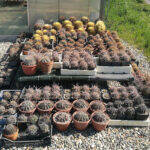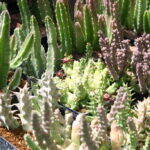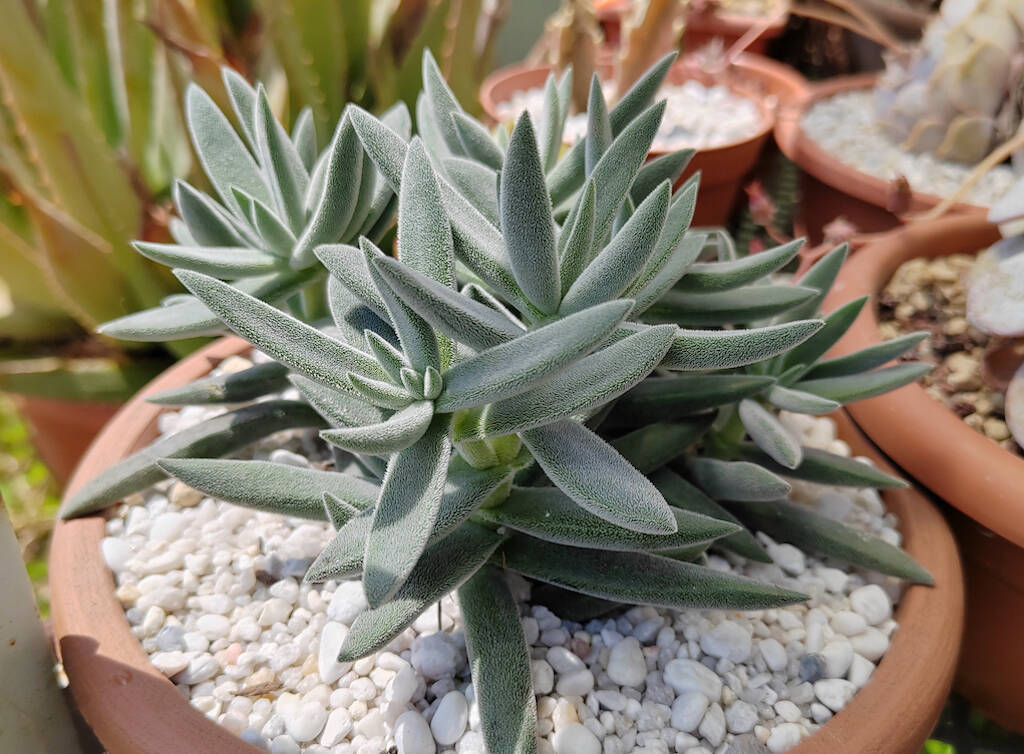After an almost non-existent, anomalous and ugly spring (at least here in Italy), the temperatures have risen considerably and we are heading towards summer. In some respects, the most delicate period for cacti and succulents, i.e. the transition between the end of winter and the vegetative restart, is now behind us and the next few months will be rather “quiet” for those who cultivate these plants. In fact, the main commitments will concern watering and fertilization, since repotting should by now be completed and treatments against pests and parasites can be given when necessary and not systematically. Even in the period of full vegetation of cacti and succulents, however, there are pitfalls and there are some elements and factors of cultivation to be taken into due consideration.
We see them in detail in the following article (…).
Premise
By the time of June, two first dangers for succulent plants should have passed by now, if we have done everything correctly (and regardless of the fact that this spring has been quite anomalous). I am referring to the danger of cracks on the cacti stems and that of burns following a late or “hasty” exposure. Once the cacti have resumed vegetating after the winter stasis, in fact, it may happen that following the first waterings (if too abundant or too close together) the stem “splits”. In this period of the year, even in the case of a wet and cold spring like the latter, cacti and succulents should have already received at least two or three waterings and the stems of the plants should have swollen. If the recovery has taken place gradually and the plants have returned swollen, the risk of stem splitting for this year can be said to have been archived.
In some ways similar speech in terms of exposure: to date all the plants should have been in their ideal location for some time now, where they will remain until autumn. In other words, those who kept cacti and succulents in the basement, entrance halls or garages should have moved the plants to full light (or half light depending on the genre) by now, under penalty of etiolation. Abruptly moving the plants now, with the June sun starting to get stronger, can expose the plants to the risk of severe burns on the stems. Whether the spring is cool or not, whether it is humid or not, the plants must be gradually accustomed to intense sun or direct sun and this must be done between the end of March and the beginning of April. In this way cacti and succulents are able to get used to direct sunlight very gradually, strengthening the epidermis well before the summer sun hits them. If you haven’t moved your plants yet, do it immediately but repair them with shading nets (especially during the hottest hours of the day), otherwise the first burns will begin to appear in the coming weeks!
Maximum air

Having exhausted the necessary premises, which are nothing if not common practices in the correct cultivation of cacti and succulents in general, we recall that the main element of cultivation, at this point, is trivially… the air. Trivially, because this element is often underestimated, or even not considered at all, taking it for granted. The air, on the other hand, is the main factor for the healthy growth of any plant and in this season, with temperatures starting to rise significantly (on sunny days in a completely open greenhouse it can easily exceed 40 degrees Celsius already in June, let alone August), the plants need as much air circulation as possible.
Anyone who cultivates in a very large professional greenhouse will have to open the structure as much as possible, raising the side curtains and possibly leaving the front and rear doors open. Those who cultivate on balconies and terraces should have no problems whatsoever, while those who cultivate in those small greenhouses covered with a transparent cloth must do nothing but… get rid of the greenhouses, remove all the plants from there and disassemble the greenhouses, which can return comfortable, at best, in winter (although they are still not the best due to the limited air circulation they allow). In this period, if we keep the plants in this type of structure, even by raising the openings in the transparent sheet to the maximum, we will still not be able to ensure the plants the air they need, and with high temperatures and humidity the risk of “boiling” plants or creating the ideal environment for the formation of molds and fungi is very high. Therefore, if you haven’t already done so, remove the greenhouses (which can be simply used as shelves) and, since the plants will not be sufficiently accustomed to the intense sun, shield them with a not too light shading net.
The importance of air and light for succulents plants.
Watering and aestivation
In this period, even if the temperatures are not yet very high this year, it is advisable to increase the frequency of irrigation. If the days are sunny and the weather does not predict rain for the following days, it can be watered once a week. The pace can also be increased to two waterings per week for some species or succulent leafy plants if slight wrinkling is noted. As always, the basic rule is to water only when the substrate appears dry and, if in doubt, postpone it. Beware of the hot months, i.e. July and August, when the difference between the maximum and minimum night-time temperatures is minimal: in conditions of persistent heat, many cacti and many succulents can go into aestivation, slowing down or blocking their growth. In these periods it is better not to water at all, since the plants do not absorb water and the soil would remain moist for too long, with the risk of root rot being triggered.
A few more waterings will have to be reserved for very young plants and seedlings, which are not yet able to tolerate long periods of drought in hot conditions and, at the same time, “push” more than adult specimens.
On the phenomenon of aestivation you will find a specific article at this link.
Fertilization and treatments
In June it is still possible to fertilize succulents. A fertilization is enough, assuming that a first fertilization was given in May or April. If the plants have been repotted a few months ago it will not be necessary to add fertilizer to the water, but if we are dealing with specimens that have lived in the same soil for years, an extra fertilization can be useful to replenish the nutrients once present in the substrate. Pay attention to the product (whether it is in powder or liquid form, it matters little), which must be specific for succulent plants and therefore low in nitrogen and rich in phosphorus and potassium, in addition to microelements. During the real summer, that is in the months of July and August, the fertilizations must instead be suspended.

As for treatments, for years I have minimized the use of pesticides and I only use copper oxychloride and Neem oil. The first is a fungicide which should be administered by nebulization only in the months in which the plants are not in vegetation (in this period it should therefore be avoided). The second is a natural product, with low environmental impact, against parasites, mites and with a modest fungicidal function. Neem oil can be administered, always by nebulization, even in this period, with the foresight to act only when the sun has gone down or early in the morning, before direct light reaches the plants. Targeted fungicides and insecticides can be used in specific cases, for example in the event of an attack by the cochineal or rot that affects several plants. In these cases it is always important to isolate sick specimens from healthy ones and carry out targeted treatments every two weeks.
Always remember that the best weapon against pests and diseases of succulents is correct cultivation, in particular a spartan cultivation, with lots of light, lots of air, little fertilization and little fertilizing.
To repot or not to repot?
In this case there is no definitive answer: during the summer it is possible to repot. Personally I prefer to avoid – except in cases in which the intervention cannot be deferred as the plant is in evident state of suffering and has probably lost its roots – and to postpone repotting until the end of winter and spring. With new purchases, especially if the plants are in peat, repotting is instead recommended at any time of the year: it is better to stress the plant a little rather than leave it in an unsuitable substrate, running the risk of triggering rot. As always, if you repot and clean or shorten the roots, it is important to leave the flared plant in a shady place for at least ten days before repotting. After repotting, wait another week or two before watering, so as to give the roots time to heal effectively. This precaution is especially important in spring and summer, when the plants are growing and are watered regularly: obviously in winter the problem does not arise, since many succulents and almost all cacti must be kept in dry soil.
Other practices

Otherwise, summer is a relatively quiet time for the cactus and succulent grower. It is sufficient to observe the specimens and understand whether they are slowing down their growth (aestivation) or not and adjust accordingly with watering. Finally, a little maintenance certainly doesn’t hurt: you can cut the now dry floral stems in the case of plants such as Aloe, Echeveria, Crassulaceae, etc., just as it is a good thing to remove the dried flowers of the cacti, which with watering they soak in water and can feed molds and fungi.
Seasonal cures in detail
If you want a complete picture of seasonal care, with everything you need to do in spring, summer, autumn and winter to take care of cacti and succulents in the best possible way, you can consult this summary article.
The site shop
SUBSCRIBE TO THE SITE – If you liked this article, subscribe to the site to have access to all the contents for one year or three months depending on the formula you choose. Here you will find terms and conditions.
SUBSCRIBE TO THE NEWSLETTER – If you want to receive the free newsletter every time new content is published (even if you have not subscribed to the site), fill in the fields at this link!
Correlated articles
Watering cacti and succulents: when and how
How to repot cacti and succulent plants
Substrates for cacti and succulents
The correct soil: the materials you can use
© The texts, videos, photos and graphic elaborations of the site “Il fiore tra le spine” are original material and are covered by copyright. It’s forbidden to reproduce them in any way.



